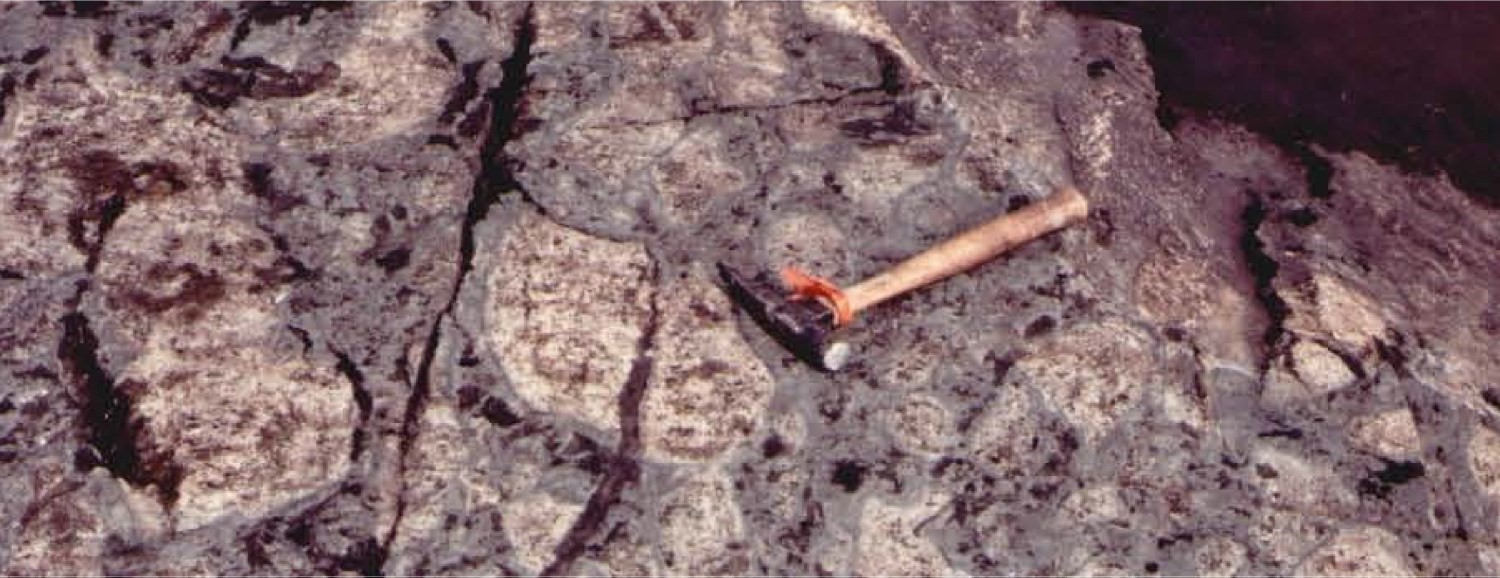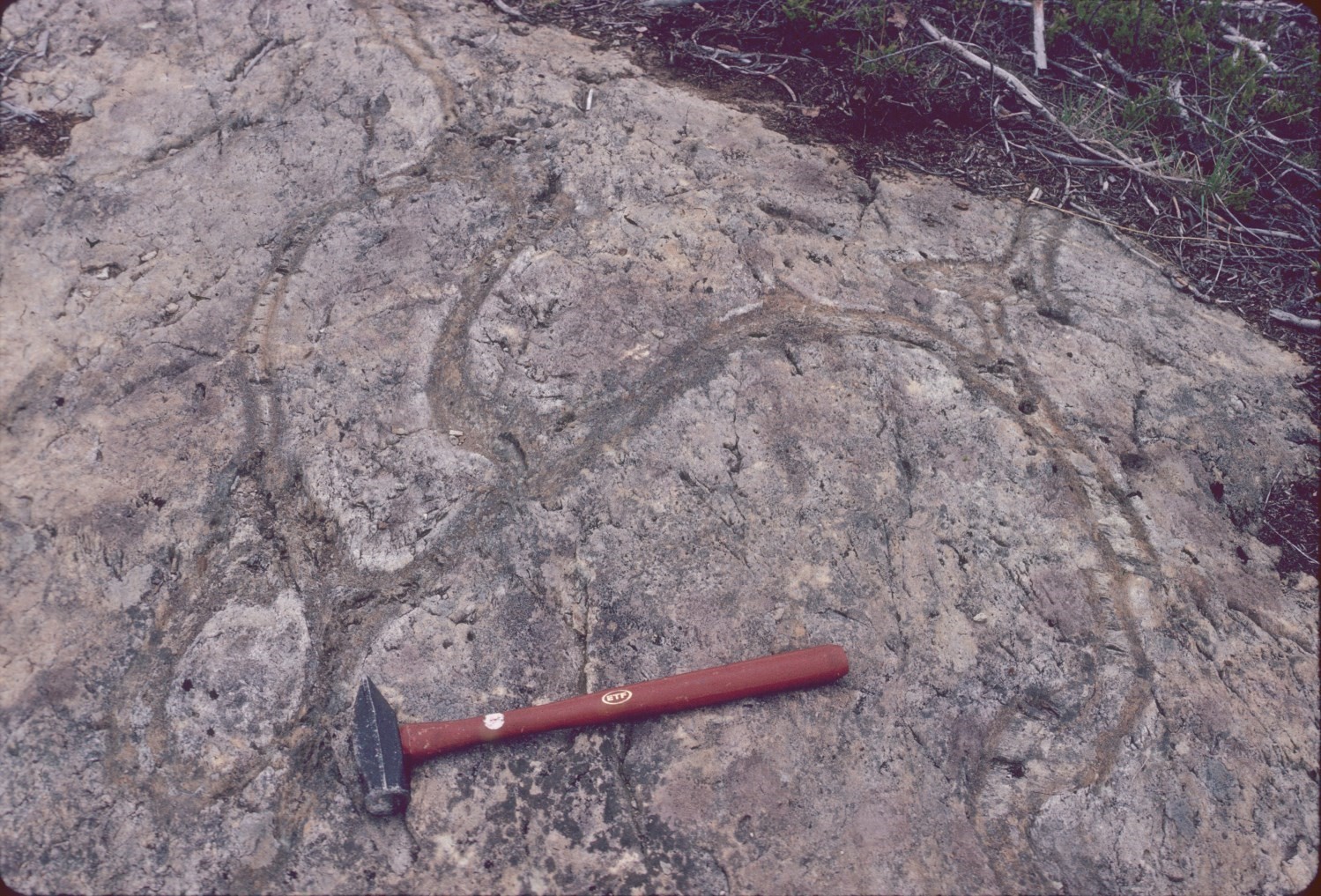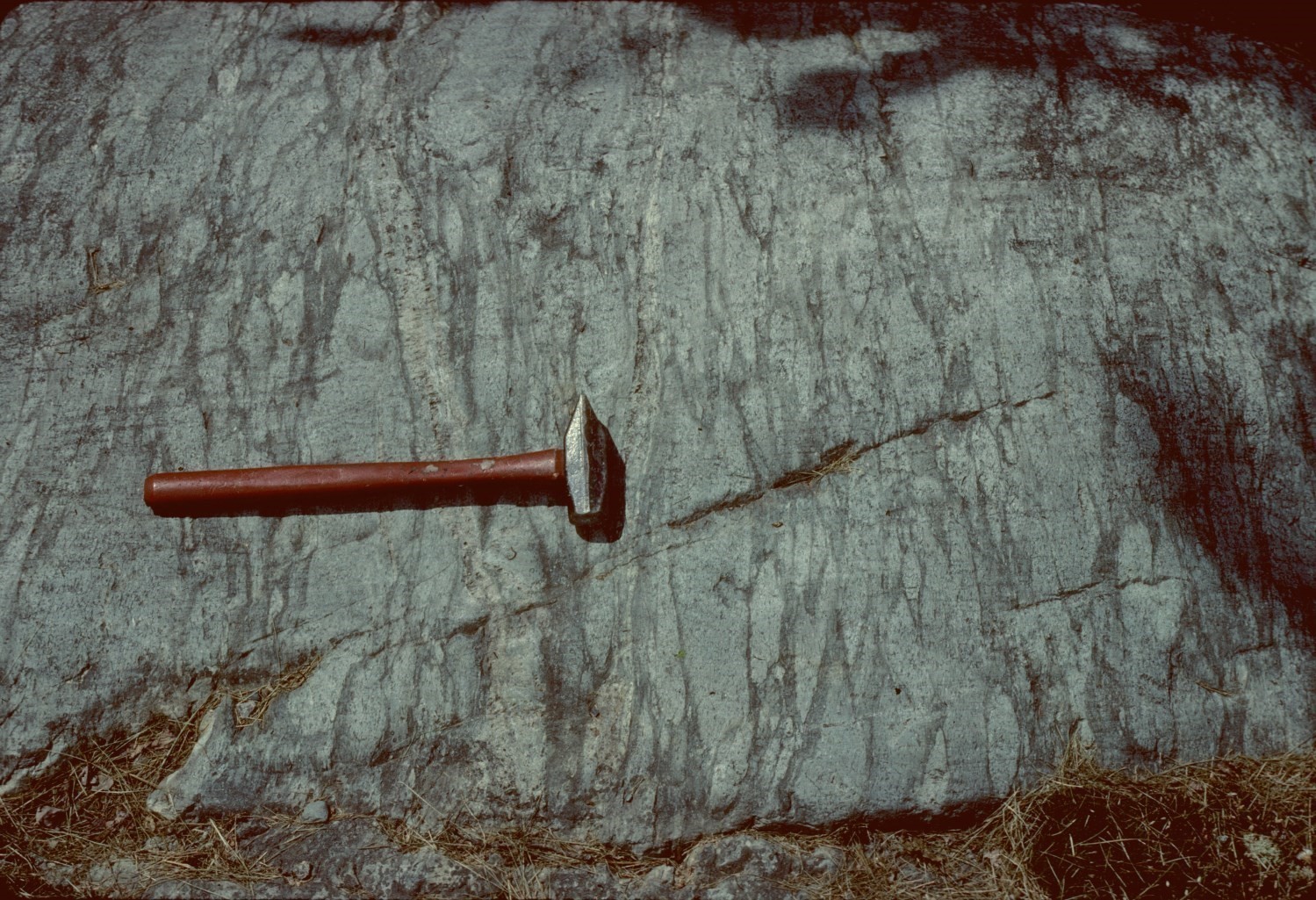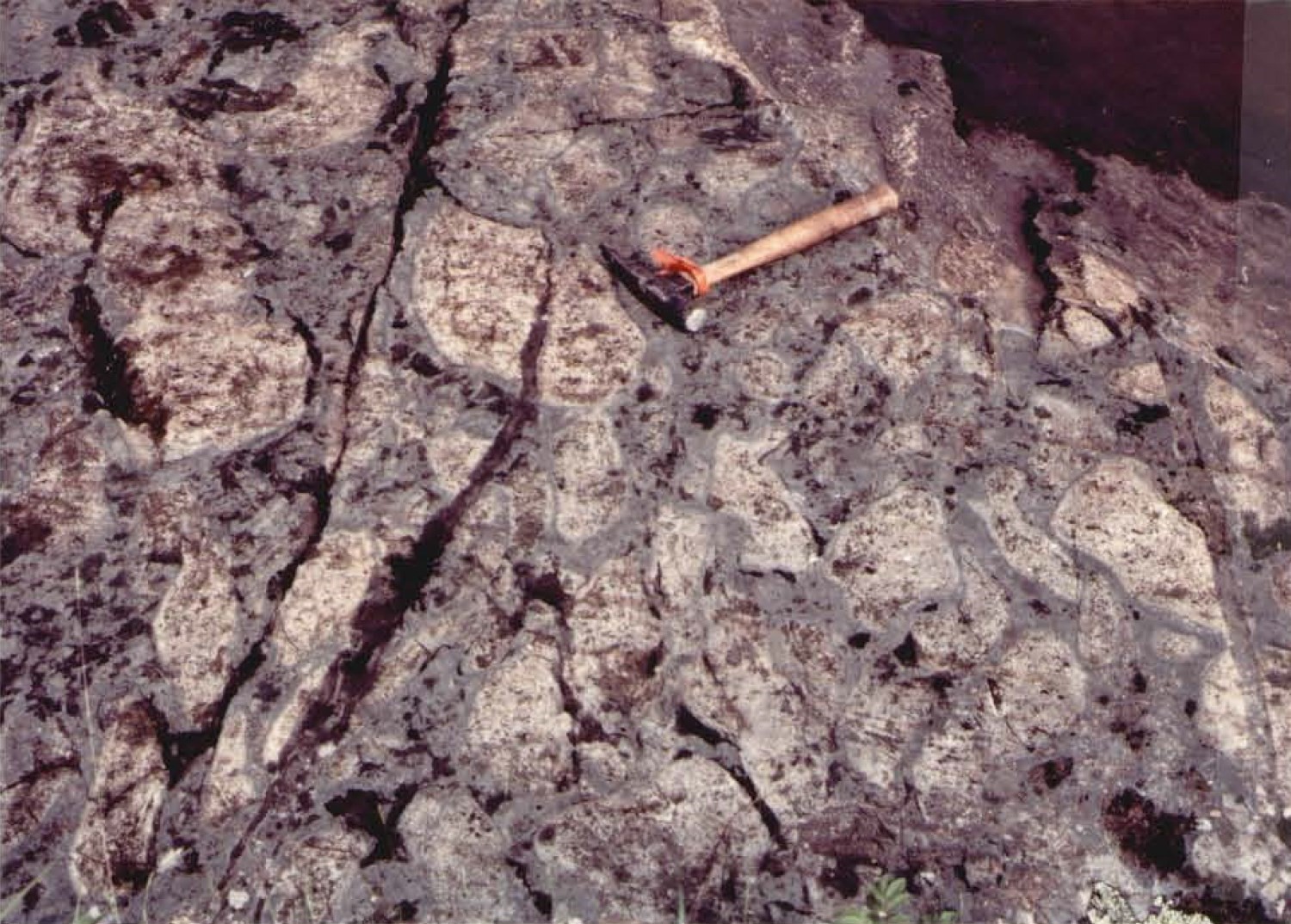
Last modified:
Translation of original French
nAfg12 Sheared intermediate to felsic volcanics
nAfg11 Andesitic basalt or basalt
nAfg10 Sheared sericitized pyrophyllite felsic volcanics
nAfg9 Mudstone and graphite siltstone
nAfg8 Dacite
nAfg7 Rhyolite, dacite and felsic tuff
nAfg6 Intermediate volcaniclastics
nAfg5 Intermediate to mafic volcanics and intermediate tuff
nAfg4 Plagioclase porphyritic andesite
nAfg3 Intermediate and felsic tuff
nAfg2 Pyrite-graphite tuff
nAfg1 Andesite, basalt, gabbro and felsic to intermediate volcaniclastics
| Author: | Imreh, 1979; Labbé, 1995 |
| Age: | Neoarchean |
| Reference section: | None |
| Type area: | NTS sheets 32D08, 09, 10, 14 and 15, as well as 32C05, 06, 11 and 12 |
| Geological province: | Superior Province |
| Geological subdivision: | Abitibi Subprovince |
| Lithology: | Volcanic and volcaniclastic rocks |
| Type: | Lithostratigraphic |
| Rank: | Group |
| Status: | Formal |
| Use: | Active |
None
Background
The current Figuery Group occupies the southern portion of the Taschereau-Amos-Senneterre Archean volcanic rock segment (Faure, 2016). Webber and Latulippe (1964) were the first to map in detail (1:24 000 scale) the various volcano-sedimentary and intrusive lithologies making the eastern portion of this segment, particularly in the Amos area. At that time, no formal formation names had been proposed; volcanic units were then known as Keewatin (Wilson, 1938; Tremblay, 1950).
The first mention of the term “Figuery” should be attributed to Imreh (1979). Between the early 1970s and the mid-1980s, numerous geological surveys by Imreh and collaborators covering the southeastern part of Abitibi (particularly the Val-d’Or, Malartic and Amos areas) formed the basis for initially proposing the formation terms « Lower Figuery », « Middle Figuery » and « Upper Figuery » (Imreh, 1979). They then proposed to include the new Figuery and Landrienne formations in the Harricana Group.
In 1982, Imreh published a memoir summarizing ten years of reflection on the volcanology, stratigraphy and metallogeny of the La Motte-Vassan trough. He then retained only the formation titles « Lower Figuery » and « Upper Figuery », which remain combined with the Landrienne Formation to form the Harricana Group. Regional mapping continued according to this stratigraphic scheme with Beullac (1983) in the Barraute area, Otis and Béland (1986) in the La Morandière-Rochebeaucourt-Carpentier area, Imreh and Beullac (1987) in the Preissac-La Pause-Cléricy area, and Labbé (1994) in the Amos area.
In 1995, Labbé completed its mapping work in the Amos area, proposing to change the names of the Lower and Upper Figuery formations for the Lower and Upper Figuery groups. The qualifiers “lower” and “upper” have been retained to distinguish two slightly distinct rock types, but part of a single calc-alkaline affinity package (Labbé, 1995). The author also proposes to abandon the term “Harricana Group” because the two historically concerned stratigraphic units (Figuery and Landrienne; Imreh, 1982) have distinct geochemical affinities and are separated by important fault zones (Abcourt and Lyndhurst faults). The Landrienne Formation then became a group (Labbé, 1995), but the latter was brought back to the rank of formation by Pilote et al. (2009). Later, Doucet and Dion (1998a, b) mapped the Languedoc-Authier Nord area, and Doucet (2000) the Taschereau, Sainte-Gertrude-Manneville and Villemontel areas, applying the new stratigraphic nomenclature of Labbé (1995).
In a geological synthesis published by Labbé (1999) covering the Amos area (sheets 32C12 and 32D09), the author modified the previous stratigraphic scheme and proposes to combine the “lower” and “upper” segments of the Figuery Group under the unique name “Figuery Group”. This nomenclature is taken by Pilote et al. (2019) with some local adjustments. The Figuery Group is now divided into 14 informal units. In summary, the Lower Figuery was replaced by units nAfg1 to nAfg3, and the Upper Figuery by units nAfg4 to nAfg14, so as to homogenize the stratigraphy and keep as much as possible previous geological observations.
Description
Units in the southern portion of the Taschereau-Amos-Senneterre segment were described based on the work of Weeks (1935), Tremblay (1956), Webber and Latulippe (1964), Imreh (1979, 1982), Vogel and Keating (1979), Ciesielski (1980), Hébert (1981 and 1982), Otis and Béland (1986), Labbé (1994, 1995 and 1999), Doucet and Dion (1998a, 1998b), Doucet (2000) and Faure (2016). The general stratigraphic sequence below is described from the base to the top.
Figuery Group 1 (nAfg1): Andesite, Basalt, Gabbro and Felsic to Intermediate Volcaniclastics
This is the largest unit of the Figuery Group. This unit consists mainly of andesite and calc-alkaline basalt, as well as some horizons of felsic to intermediate volcaniclastics. Rocks are usually pillowed, but some massive flows have been observed and form large horizons a few tens of metres thick. These rocks are green in alteration patina, light green in fresh exposure and aphanitic. Gabbro sills intrude into these volcanics (Labbé, 1995; Doucet and Dion, 1998a, b).
Figuery Group 2 (nAfg2): Pyrite-Graphite Tuff
This fragmented unit is interstratified in unit nAfg1, in the western part of the segment occupied by the Figuery Group, more specifically in sheets 32D10 and 32D14.
Figuery Group 3 (nAfg3): Intermediate and Felsic Tuff
Unit nAfg3 is located in the NW end of the group. It consists of several horizons of lapilli and block tuff and lapilli tuff of intermediate composition, usually a few metres to a few tens of metres thick. This unit is interstratified with intermediate volcanics. These rocks are usually beige to yellowish in alteration patina and light grey in fresh exposure. Lapilli tuff and lapilli and block tuff are characterized by rounded to subangular, millimetric to decimetric fragments of mafic, intermediate or felsic volcanics in an aphanitic matrix. In general, these fragmented volcaniclastics are poorly sorted and do not show lapilli or block sorting (Doucet, 1998).
Figuery Group 4 (nAfg4): Plagioclase Porphyritic Andesite
Unit nAfg4 consists mainly of light green pillow andesitic flows, commonly plagioclase porphyritic and that may contain flattened chlorite amygdules. In general, pillows observed in these rocks are very large (mega pillows are 1-3 m thick) and have chilled margins up to 15 cm thick (Labbé, 1995).
Figuery Group 5 (nAfg5): Intermediate to Mafic Volcanics and Intermediate Tuff
Unit nAfg5 is located in Launay Township. It consists of intermediate and mafic volcanic rocks that form generally massive, locally pillowed flows. These rocks are green in alteration patina, light green in fresh exposure and fine grained (Doucet, 2000).
Figuery Group 6 (nAfg6): Intermediate Volcaniclastics
Unit nAfg6 is observed in lenses of limited extent hosted between andesitic flows (nAfg1 and nAfg4; sheet 32D09) or within unit nAfg7 (sheets 32C05 and 32C12). This unit consists of volcaniclastic horizons of intermediate composition. Fragments are commonly of lapilli size and, more locally, of block size (Labbé, 1995).
Figuery Group 7 (nAfg7): Rhyolite, Dacite and Felsic Tuff
The largest proportion of Figuery Group felsic volcanics occurs in unit nAfg7. It consists of rhyolite and felsic tuff horizons, greenish white in alteration patina, light grey in fresh exposure, microgranular and even grained. Lapilli tuff horizons a few metres thick were also observed. They are composed of subrounded fragments of felsic volcanics, 0.5-3 cm in diameter, in an aphanitic matrix. This unit is commonly located in the upper part of the Figuery Group (Doucet, 2000; Lavallée and Bourgoin, 2003).
Figuery Group 8 (nAfg8): Dacite
Unit nAfg8 consists of lenticular dacite horizons, particularly abundant in the northern part of Barraute Township. Dacite is grey and occurs as massive flows (Labbé, 1995).
Figuery Group 9 (nAfg9): Mudstone and Graphite Siltstone
Unit nAfg9 consists of three thin horizons of graphitic sedimentary rock. This unit is located west of Figuery Lake (sheet 32D09). Many other similar beds, but too thin to be mapped, are found at various stratigraphic levels in unit nAfg4.
Figuery Group 10 (nAfg10): Sheared Sericitized Pyrophyllite Felsic Volcanics
These horizons of sheared and sericitized pyrophyllite±chloritoid felsic volcanics are located at the contact between sheets 32C06 and 32C11. Rocks are commonly described as quartz-pyrophyllite±chloritoid±muscovite±paragonite schists. Geochemical data indicate that the protolith of these schists may correspond to rhyodacitic to rhyolitic flows and/or tuff horizons of calc-alkaline affinity (Lavallée and Bourgoin, 2003). These lithologies have been significantly altered by hydrothermal fluids and severely affected by regional deformation. They are totally interstratified in unit nAfg7, which is the best estimate of their protolith.
Figuery Group 11 (nAfg11): Andesitic Basalt or Basalt
Unit nAfg11 is located at the SE end of the Figuery Group and interstratified in an andesitic unit (nAfg4). It consists of andesitic basalt or basalt and locally mafic tuff. A limited amount of data is currently available to describe this unit, which was observed by Lavallée and Bourgoin (2003).
Figuery Group 12 (nAfg12): Sheared Intermediate to Felsic Volcanics
Unit nAfg12 consists of intermediate felsic tuff located at the base of unit nAfg10. It is affected by significant shearing associated with the Lyndhurst Fault. This fault zone would be located at contact between the Figuery Group and the Deguisier Formation (Moorhead, 1992; Lavallée and Bourgoin, 2003).
Figuery Group 13 (nAfg13): Rhyolite
Unit nAfg13 is located NE of sheet 32C06. It consists of rhyolite and rhyolitic tuff containing, in several places, quartz and plagioclase crystals and blocks. Blocks are highly flattened and generally of the same nature. A deformation zone severely obliterates primary fabrics in the eastern part of this unit. Pyrophyllite and chloritoid porphyroblasts are observed in varying amounts (Lavallée and Bourgoin, 2003).
Figuery Group 14 (nAfg14): Undifferentiated Volcaniclastics, Wacke and Quartzitic Arenite
Unit nAfg14 was historically recognized by Eakins (1974) in Privat Township in the NW portion of sheet 32D10. It consists of two large enclaves, several hundred metres long, hosted in a vast gabbroic intrusion. These enclaves consist of sedimentary rocks of various compositions from wacke to quartzitic arenite, as well as undifferentiated volcaniclastics.
Thickness and Distribution
The Figuery Group is located in the southern part of the Taschereau-Amos-Senneterre Volcano-Sedimentary Band (Faure, 2016) and extends >150 km along a WNW-ESE axis. This group is bordered on the south and north by regional faults. Its width ranges from a few hundred metres to >10 km at the centre (sheet 32D09). Units belonging to this group are found in sheets 32D08, 09, 10, 14 and 15, as well as 32C05, 06, 11 and 12.
Dating
No U-Pb zircon dating is currently available for Figuery Group volcanics. On the other hand, the tonalitic to granodioritic Taschereau Batholith (Doucet, 2000) intrudes into Figuery volcanics in the northern half of sheet 32D10. This intrusion appears to be devoid of contact metamorphism (Doucet, 2000). Frarey and Krogh (1986) dated this pluton by U-Pb on zircons and obtained an age of 2718.3 +2.3/-2.2 Ma, a result interpreted by Frarey and Krogh (1986) as synvolcanic. This interpretation is also mentioned and supported by the work of Doucet (2000). The age obtained by Frarey and Krogh (1986) implies that the average age of the Figuery Group volcanics should be comparable to that of this intrusion, or slightly older.
Stratigraphic Relationship(s)
The Figuery Group is bordered to the north by the Amos Group (Imreh, 1979) and to the south by the Deguisier Formation. The southern boundary of this segment of Archean volcanic rocks is bordered by the Macamic and Lyndhurst regional faults, while the northern boundary is bordered by the Beauchamp Fault (Labbé, 1995). All these lithologies are oriented along a WNW-ESE general direction and are steeply dipping to the north (Lavallée and Bourgoin, 2003).
Paleontology
Does not apply.
References
Publications available through Sigéom Examine
BEULLAC, R. 1983. Région de Barraute-Fiedmont. Ministère des Richesses naturelles, Québec; DP-84-02, 1 plan.
BEULLAC, R., IMREH, L. 1987. Géologie du secteur de Preissac-La Pause-Clérucy (Abitibi). Ministère des Richesses naturelles, Québec; ET 86-03, 44 pages and 1 plan.
CIESIELSKI, A. 1980. Géologie du canton de Villemontel (Comté d’Abitibi-Ouest). Ministère des Ressources naturelles, Québec; DPV 706, 78 pages and 1 plan.
DOUCET, P., DION, D.-J. 1998a, Géologie de la région de Languedoc (SNRC 32D/15-200-0 1 02). Ministère des Ressources naturelles, Québec; RG 98-12, 29 pages.
DOUCET, P., DION, D.-J. 1998b, Géologie de la région d’Authier-Nord (SNRC 32D/15-200-01 01). Ministère des Ressources naturelles, Québec; RG 98-11, 28 pages.
DOUCET, P. 2000. Géologie de la région de Taschereau, de Sainte-Gertrude-Manneville et de Villemontel. Ministère des Ressources naturelles, Québec; RG 2000-08, 34 pages and 3 plans
EAKINS, P R. 1974. Preliminary report on the geology of Privat township, Abitibi-West County. Ministère des Ressources naturelles, Québec; DP 222, 13 pages and 2 plans.
HÉBERT, R. 1981. Lithostratigraphie du canton de Villemontel (comté d’Abitibi-Est). Ministère des Ressources naturelles; Québec; DP 785, 18 pages and 2 plans.
HÉBERT, R. 1982. Géologie du complexe de filons-couches d’Amos, Québec. Ministère des Ressources naturelles; Québec; DP 786, 28 pages and 1 plan.
IMREH, L. 1984. Sillon de La Motte-Vassan et son avant-pays méridional : synthèse volcanologique, lithostratigraphique et gîtologique. Ministère de l’Énergie et des Ressources, Québec; MM 82-04, 72 pages.
LABBÉ, J.-Y. 1994, Synthèse géologique de la région d’Amos, Abitibi. Ministère des Ressources naturelles, Québec; MB 94- 09, 13 pages.
LABBÉ, J.-Y. 1995. Géologie de la région d’Amos – Comté d’Abitibi-Est. Ministère des Ressources naturelles, Québec; MB 95-24, 27 pages.
LABBÉ, J.-Y. 1999. Études géologiques dans la région d’Amos. Ministère des Ressources naturelles, Québec; ET 98-04, 87 pages.
LAVALLÉE, J.-S., BOURGOIN, M. 2003. Rapport d’une campagne de 9 Sondages au diamant – MRB associés; Consultants miniers, Québec; Ministère de l’Énergie et des Ressources du Québec; GM 60879, 482 pages.
OTIS, M., BÉLAND, G. 1986. Projet de cartographie, région d’Amos. Ministère de l’Énergie et des Ressources du Québec; MB 86-21.
PILOTE, P., MARLEAU, J., DAVID, J. 2019. Géologie de la région de Barraute, Sous-province de l’Abitibi, région de l’Abitibi-Témiscamingue, Québec, Canada. MERN. BG 2019-06.
PILOTE, P., McNICOLL, V., DAIGNEAULT, R., MOORHEAD, J. 2009. Géologie et nouvelles corrélations dans la partie ouest du Groupe de Malartic et dans le Groupe de Kinojévis, Québec. Ministère de l’Énergie et des Ressources naturelles, Québec; MB 2009-09, pages 55-60.
VOGEL, D E., KEATING, P. 1979. Canton de Trecesson. Ministère des Ressources naturelles, Québec; RG 194, 50 pages and 2 plans.
WEBER, W.W., LATULIPPE, M. 1964. Région d’Amos- Barraute, comté d’Abitibi-est. Ministère des Richesses naturelles, Québec; RG-109.
Other publications
FAURE, S. 2016. Le segment volcanique Taschereau-Amos-Senneterre (Abitibi) et son potentiel métallogénique pour l’or et les métaux de base. Consortium de recherche en exploration minéral (CONSOREM); Projet 2015-01, 59 pages.
FRAREY, M.J., KROGH, T.E. 1986. U-Pb zircon ages of late internal plutons of the Abitibi and eastern Wawa subprovinces, Ontario and Quebec. Current Research, Part A, Geological Survey of Canada, Paper 86-1A, pages 43–48. http://dx.doi.org/10.4095/120343.
IMREH, L. 1979. Lithostratigraphie et roches ultramafiques du secteur de Val-d’Or – Amos. Association géologique du Canada – Association minéralogique du Canada, Québec conference, 1979; field trip guidebook A-4, pages 1–40.
ROSS, P.-S., BÉDARD, J.H. 2009. Magmatic affinity of modern and ancient subalkaline volcanic rocks determined from trace-element discriminant diagrams. Canadian Journal of Earth Sciences; volume 46, pages 823–839. http://dx.doi.org/10.1139/E09-054.
TREMBLAY, L.-P. 1956. Région de Fiedmont. Geological Survey of Canada; Memoir 253, 141 pages and 1 map. http://dx.doi.org/10.4095/119963.
WEEKS, L.J. 1935. Amos sheet, Abitibi County, Quebec. Geological Survey of Canada; map 327A. http://dx.doi.org/10.4095/107158
WILSON, M.E. 1938. The Keewatin lavas of the Noranda district, Quebec. Toronto University, Studies No.41, pages 75–82.
WINCHESTER, J.A., FLOYD, P.A. 1977. Geochemical discrimination of different magma series and their differentiation products using immobile elements. Chemical Geology; volume 20, pages 325–343. http://dx.doi.org/10.1016/0009-2541(77)90057-2.




